In this post, we will show you how to limit how much bandwidth is used for downloading updates in the background or foreground by Windows 11/10 using Settings or Group Policy Editor. Windows allows you to limit the bandwidth that your computer can consume for Windows Updates. This can be rather useful if you are on a limited data connection and want to control your data usage. If you are on an unlimited data pack, you may not find this feature very useful.
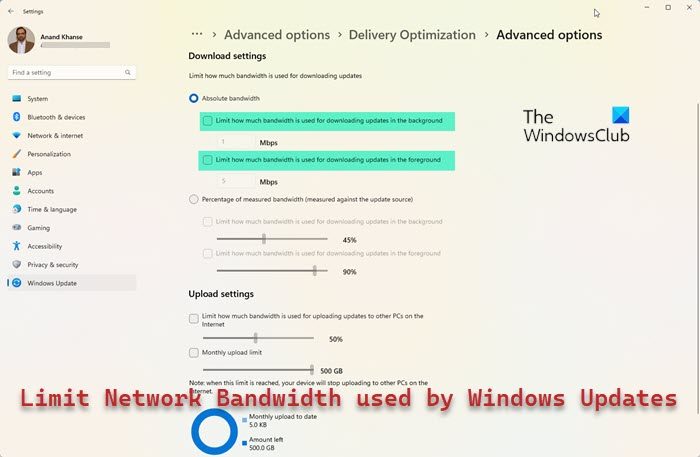
There are two types of downloads that are being done in Windows OS, namely – the Foreground downloads and the Background downloads. Before limiting the bandwidth of foreground downloads, we must understand their properties, after which we will talk about how to limit their bandwidth.
What are Foreground downloads and the Background downloads?
Background downloads are downloads that are involuntarily conducted by your operating system. These are usually the updates done on Windows and are automatically downloaded without asking for permission or any interaction with the user. Whenever there are any update requirements, you see them getting updated right away.
Foreground downloads are the kinds of downloads that one has to start by oneself. A very good example of a manual or a foreground download is the one where we click on Get or a Download button so that we can download an update or an application.
Both foreground and background downloads affect the bandwidth of the system, and if they go beyond a certain limit, they could saturate the disk utilization. A good way to find out the same is by opening the Task Manager and checking the percentage of Disk utilization. If it is in red, we have to limit the downloads to reduce the load on the system, or else it would start hanging and might get totally unresponsive.
How to limit Windows Update bandwidth in Windows 11
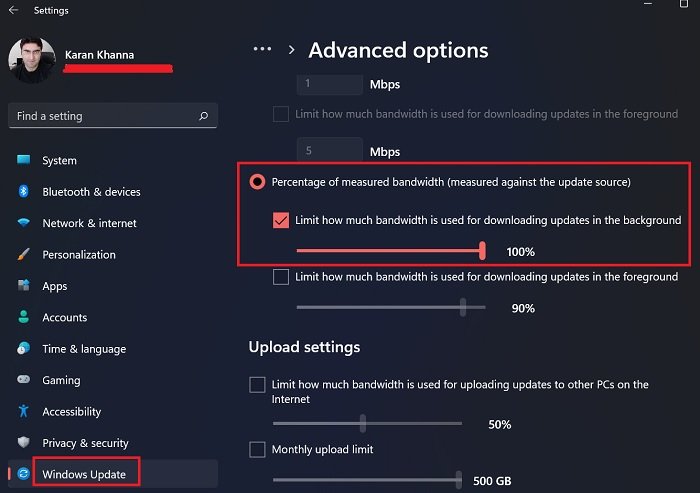
Since a lot of settings have been added for Windows 11, the approach and options have changed with the Windows 11 Settings menu. One such case is with the Delivery Optimization options. If you are using a limited data network for your system and don’t want to exhaust all of your data for downloading Windows updates, then you can set a specific percentage of the data which can be used for updating your system. The procedure to limit Windows Update bandwidth in Windows 11 is as follows:
- Right-click on the Start button and select Settings.
- Go to the Windows Update tab on the list on the left-hand side.
- In the right-pane. select Advanced options.
- Scroll down to the menu under Additional options and click on Delivery Optimization.
- Now, scroll down and click on Advanced options.
- In this menu, under Download settings, you would find Limit how much bandwidth is used for downloading updates.
- Check the radio button associated with Percentage of measured bandwidth.
- Now, check the box associated with Limit how much bandwidth is used for downloading updates in the background.
- Using the slide bar, you can set the percentage of the total available bandwidth to be used to download the updates.
Do note that you can set the network bandwidth limits for foreground as well as background downloads.
Limit bandwidth of Foreground or Background downloads in Windows 10
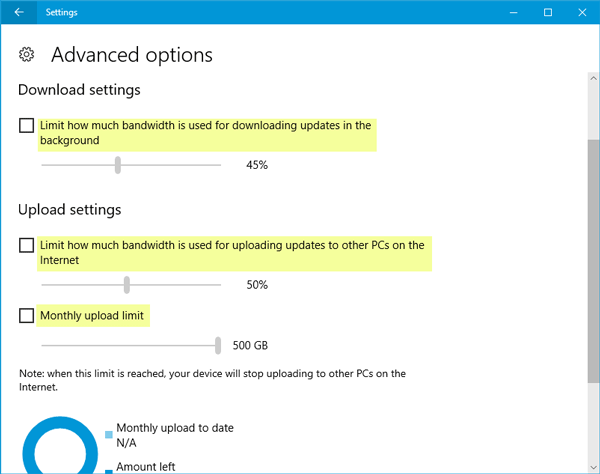
To limit data consumption for Windows Updates in Windows 10:
- Open Windows Settings panel by pressing Win+I button
- Select Update & Security >
- Click Windows Update >
- Navigate to Advanced options (under Update Settings)
- Click Delivery Optimization
- Go to Advanced options.
- You will find Download settings and Upload settings.
Select the checkbox that says, “Limit how much bandwidth is used for downloading updates in the background.” After that, you can select a percentage of the bandwidth. By default, it is set to 45%. But, you can change it using the slider.
Do note that you can set the network bandwidth limits for foreground as well as background downloads.
The same thing can be done with the Upload settings. You would be able to set the Monthly upload limit if you want to limit the uploading bandwidth by either percentage or data (5 GB to 500 GB).
The uploading bandwidth limitation feature works only when you have enabled Allow download from other PCs option that comes under Delivery Optimization. If you haven’t activated this feature, the “Upload Settings” options are not mandatory.
Once the predefined limit is reached, all the update activity will be stopped automatically.
You can also check how much data is used or available on the same page.
Read: How to specify Absolute bandwidth that can be used to download Windows Updates.
Limit how much bandwidth is used for downloading updates using Group Policy
In Windows 11/10, the same feature can be enabled with the help of the Group Policy Editor as well. To open it, press Win+R, type gpedit.msc and hit the Enter button. Next, navigate to the following path-
Computer Configuration > Administrative Templates > Windows Components > Deliver Optimization
On your right-hand side, you will find two different options-
- Maximum Download Bandwidth (in KB/s)
- Max Upload Bandwidth (in KB/s)
Double-click on an option > select Enabled > enter a value in the corresponding box (in KB/s) > click on Apply & OK.
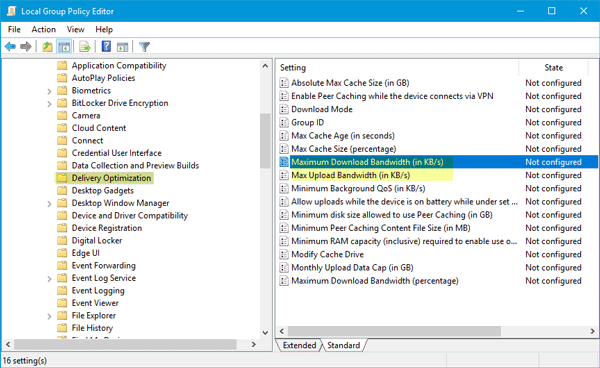
Hope this functionality will be helpful for you to limit Windows Update bandwidth usage in Windows 11/10.
How to limit Foreground downloads using Group Policy in Windows
In case we are handling a network of systems managed by a common group policy, we could make changes as follows:
1] Press Win + R to open the Run window and type the command gpedit.msc. Press Enter, and it would open the Local Group Policy Editor.
2] Scroll to the path Computer Configuration > Administrative Templates > Windows Components > Delivery Optimization.
3] On the Settings pane on the right-hand side, double-click on the Maximum Foreground Download Bandwidth (percentage) policy.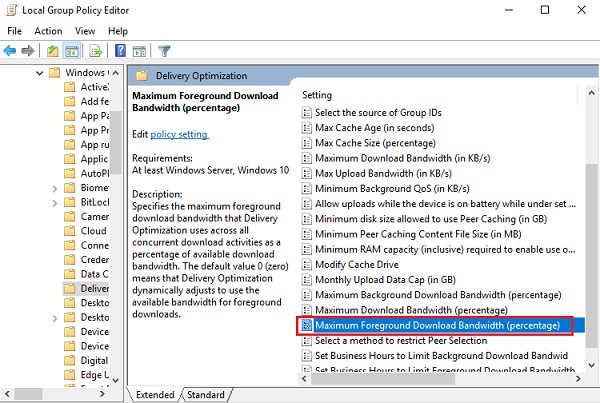
4] Select the radio button at Enabled. Under Options, change the Maximum Foreground Download Bandwidth (percentage) to whatever bandwidth you prefer.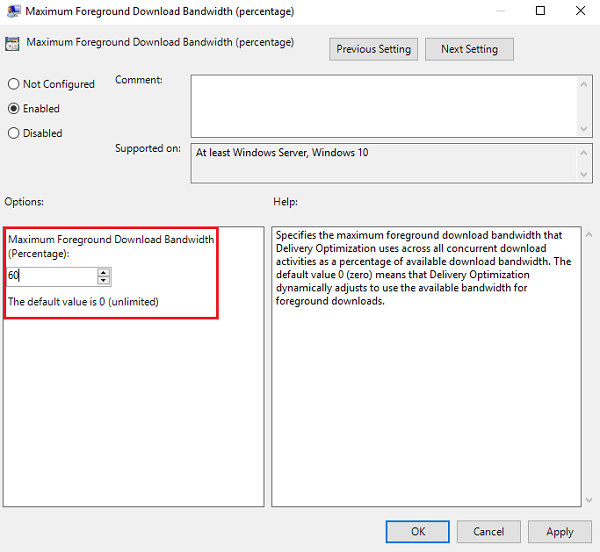
5] Click on Apply and then Ok to save the settings.
And that’s it! You have successfully set the bandwidth of your manual/foreground downloads.
How much data would Windows Updates need?
Just in case you are wondering whether or not to use the mentioned option, a general Windows Update needs hundreds of MBs of data and a featured update would need a few GBs of data. Thus, if you are using a network with limited data, then the mentioned option is the best.
Anand
you say above “Windows 10 Fall Creators Update v1903…” Do you mean version 1709?
Or have I gotten it wrong?
Oops, editing. Thanks.